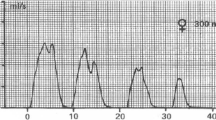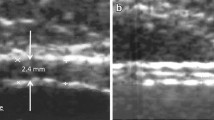Abstract
Introduction and hypothesis
The aim of the study was to investigate the correlation between mean bladder wall thickness (BWT) and treatment success in patients diagnosed with urinary incontinence, based on urodynamic test results.
Methods
In this prospective study, patient urinary incontinence type was identified using urodynamic tests. Patients (N = 125) were categorized into three groups: urodynamic stress incontinence (SUI), detrusor over-activity (DO) and mixed urinary incontinence. Measurements from the bladder dome, anterior wall and trigone were averaged to calculate BWT. Student’s t test and Mann–Whitney U test were used to compare pre-treatment BWT. Receiver operating characteristic (ROC) curve analysis was used to determine optimal cut-off values for BWT to predict treatment success.
Results
Mean pre-treatment BWT significantly differed between success and non-success groups for each urinary incontinence type (p value for the SUI, DO and MUI groups was 0.043, 0.001 and 0.002 respectively). Using ROC curves to anticipate the treatment success, a threshold was calculated for mean pre-treatment BWT; 5.05 mm for SUI (sensitivity 74 %, specificity 66 %, positive predictive value [PPV] 85 %, negative predictive value [NPV] 50 %), 4.98 mm for DO (sensitivity 73 %, specificity 92 %, PPV 95 %, NPV 63 %) and 5.31 mm for mixed type (sensitivity 88 %, specificity 73 %, PPV 79 %, NPV 85 %).
Conclusions
The study results suggest a significant relationship between the pre-treatment BWT and the success of urinary incontinence treatment. The mean BWT may be used as a benchmark in assessing the responsiveness to treatment of urinary incontinence types.

Similar content being viewed by others
Abbreviations
- BWT:
-
Bladder wall thickness
- SUI:
-
Stress urinary incontinence
- MUI:
-
Mixed urinary incontinence
- DO:
-
Detrusor overactivity
- PPV:
-
Positive predictive value
- NPV:
-
Negative predictive value
- ICS:
-
International Continence Society
- BMI:
-
Body mass index
References
Abrams P, Cardozo L, Fall M, Griffiths D, Rosier P, Ulmsten U, et al. The standardisation of terminology of lower urinary tract function: report from the Standardisation Sub-committee of the International Continence Society, vol 21. Neurourol Urodyn 21(2):167–178
Buckley BS, Lapitan MCM. Prevalence of urinary incontinence in men, women, and children—current evidence: findings of the fourth international consultation on incontinence. Urology. 2010;76(2):265–70.
Markland AD, Richter HE, Fwu C-W, Eggers P, Kusek JW. Prevalence and trends of urinary incontinence in adults in the United States, 2001 to 2008. J Urol. 2011;186(2):589–93.
Khullar V, Salvatore S, Cardozo L, Bourne TH, Abbott D, Kelleher C. A novel technique for measuring bladder wall thickness in women using transvaginal ultrasound. Ultrasound Obstet Gynecol. 1994;4(3):220–3. doi:10.1046/j.1469-0705.1994.04030220.x.
Serati M, Salvatore S, Cattoni E, Soligo M, Cromi A, Ghezzi F. Ultrasound measurement of bladder wall thickness in different forms of detrusor overactivity. Int Urogynecol J. 2010;21(11):1405–11.
Robinson D, Anders K, Cardozo L, Bidmead J, Toozs‐Hobson P, Khullar V. Can ultrasound replace ambulatory urodynamics when investigating women with irritative urinary symptoms? BJOG. 2002;109(2):145–8.
Panayi DC, Tekkis P, Fernando R, Hendricken C, Khullar V. Ultrasound measurement of bladder wall thickness is associated with the overactive bladder syndrome. Neurourol Urodyn. 2010;29(7):1295–8. doi:10.1002/nau.20871.
Uebersax JS, Wyman JF, Shumaker SA, McClish DK. Short forms to assess life quality and symptom distress for urinary incontinence in women: the incontinence impact questionnaire and the urogenital distress inventory. Neurourol Urodyn. 1995;14(2):131–9.
Haylen B. Residual urine volumes in a normal female population: application of transvaginal ultrasound. Br J Urol. 1989;64(4):347–9.
Haylen BT, De Ridder D, Freeman RM, Swift SE, Berghmans B, Lee J, et al. An International Urogynecological Association (IUGA)/International Continence Society (ICS) joint report on the terminology for female pelvic floor dysfunction. Int Urogynecol J. 2010;21(1):5–26.
Elbadawi A, Yalla S, Resnick N. Structural basis of geriatric voiding dysfunction. IV Bladder outlet obstruction. J Urol. 1993;150(5 Pt 2):1681–95.
Khullar V, Cardozo L, Salvatore S, Hill S. Ultrasound: a noninvasive screening test for detrusor instability. BJOG. 1996;103(9):904–8.
Yang J-M, Huang W-C. Bladder wall thickness on ultrasonographic cystourethrography affecting factors and their implications. J Ultrasound Med. 2003;22(8):777–82.
Arrighi N, Bodei S, Zani D, Simeone C, Cunico S, Spano P, et al. Acetylcholine induces human detrusor muscle cell proliferation: molecular and pharmacological characterization. Urologia. 2011;79(2):102–8.
Wang L, Han L, Li H. Etiological study of pelvic organ prolapse and stress urinary incontinence with collagen status and metabolism. Zhonghua Yi Xue Za Zhi. 2013;93(7):500–3.
Han L, Wang L, Wang Q, Li H, Zang H. Association between pelvic organ prolapse and stress urinary incontinence with collagen. Exp Ther Med. 2014;7(5):1337–41.
Acknowledgements
None.
Funding
No.
Author information
Authors and Affiliations
Corresponding author
Ethics declarations
Conflicts of interest
The authors declare that they have no conflicts of interest.
Rights and permissions
About this article
Cite this article
Akselim, B., Doğanay, M., Özcan, N. et al. Correlation of bladder wall thickness and treatment success in types of urinary incontinence. Int Urogynecol J 28, 417–422 (2017). https://doi.org/10.1007/s00192-016-3127-0
Received:
Accepted:
Published:
Issue Date:
DOI: https://doi.org/10.1007/s00192-016-3127-0




